![]()
![]()
![]()
Use LEFT and RIGHT arrow keys to navigate between flashcards;
Use UP and DOWN arrow keys to flip the card;
H to show hint;
A reads text to speech;
163 Cards in this Set
- Front
- Back
|
2 Types of associative learning
|
Instrumental and classical conditioning
|
|
|
Instrumental learning/conditioning
|
Conditioning that occurs when we learn about the consequences of our behavior and our behavior subsequently increases or decreases
-Stimulus-response learning |
|
|
EL Thorndike
|
Interested in studying intelligence in cats, esp. in puzzle-like situations
|
|
|
Puzzle boxes
|
box in which animal has to press a lever or some similar action to get out
|
|
|
Thorndike puzzle box experiment
|
First escape-->cat accidentally activates solution to get out b/c is in panicked state
Subsequent escapes-->less time to get out ea. time |
|
|
The Law of Effect
|
If a response in the presence of a stimulus is followed by a positive/satisfying event, then the association between the S and R is strengthened
-if a response in the presence of a stimulus is followed by an aversive/annoying event, the association between S and R is weakened |
|
|
Discrete trial procedures
|
instrumental response only occurs one time per trial
eg. puzzle box, T-maze, straight maze |
|
|
Free-operant procedures
|
animal can make as many instrumental responses as it wants
eg. bar pressing, Skinner box |
|
|
appetitive outcome
|
pleasant outcome/consequence
|
|
|
aversive outcome
|
unpleasant outcome/consequence
|
|
|
Four instrumental conditioning procedures
|
Positive Reinforcement
Punishment Negative Reinforcement Omission Training |
|
|
Postive reinforcement
|
Instrumental response brings about an appetitive consequence
e.g. giving a dog a treat for sitting, kissing and verbally praising an autistic child for following a command to stand up -INCREASES probability of response |
|
|
Punishment
|
Instrumental response brings about an aversive consequence
e.g. spanking a child for misbehaving, putting a puppy in its crate for chewing the carpet -DECREASES probability of response |
|
|
Negative reinforcement
|
Instrumental response brings about avoidance/escape of an aversive outcome
eg. -avoidance--study to AVOID failing a test -escape--apologize to ESCAPE time out -INCREASES probability of response |
|
|
Omission training
|
Instrumental response prevents something pleasant from happening
eg. If you do X, then you can't go to the amusement park DECREASES the probability of response |
|
|
4 Basic elements of Instrumental conditioning
|
1.Response
2.Outcome 3.Relationship btw Response and Outcome 4. Stimulus |
|
|
The Instrumental Response
|
Can reinforce an existing response OR create and reinforce new responses
|
|
|
How do you train a rat to press a lever in a Skinner Box?
|
Multiple phases:
1. Magazine training 2. Shaping |
|
|
Magazine training
|
Relies on classical conditioning to teach rat that food comes from magazine
Click of magazine (CS) + Food (US) Click-->hanging out at food cup (CR) |
|
|
Shaping
|
Reward successive approximations of the instrumental response eg. rearing on hind legs near bar, sniffing bar, touching bar, biting bar
|
|
|
Measures of IR
|
Cumulative record
|
|
|
Cumulative record
|
-measure of free-operant procedure
-every time org makes a response, stair-step on CR curve recorded -allows researcher to take note of changes over time -previous response carries over, but cannot go down |
|
|
Steeper slope on CR
|
faster rate of responding
|
|
|
Flat line on CR
|
no response
|
|
|
Stereotyped instrumental responding
|
Typically, instrumental conditioning causes stereotyped instrumental responding, but you can train variability in responding
*Pigeon study--> -given 2 lighted keys to peck, btw the two had to make an 8 peck sequence -over time, birds began to make same pattern of response -when made reinforcement contingent on not responding in the same sequence each time for 50 trials, pigeons learned variability -Conclusion=without explicit variability training, behavior becomes stereotyped over time |
|
|
Relevance or belongingness in instrumental conditioning
|
In instrumental conditioning, certain responses are more easily conditioned than others
eg. Thorndike-->decided to see if could train cat to yawn (IR) to be released from box (reinforcer) -could do it, but hard to maintain b/c yawning is incompatible with release from box -response doesn't fit with outcome |
|
|
Breland and Breland
|
fully believed in behaviorism and operant conditioning
-thought instinctive drift goes against operant conditioning, gets worse as time goes on -can design operant conditioning procedures that go with the flow of natural behavior eg. digging, mazes, passive avoidance |
|
|
Instinctive drift
|
tendency of conditioned behavior to drift towards instinctive behavior
-when conditioning and instinctive behavior compete, conditioning often, but not always loses |
|
|
2 features of the reinforcer (outcome) that are important
|
quantity and quality
|
|
|
quality
|
more aversive stimulus works better than less aversive stimulus in punishment
-there is an upper limit=too aversive doesn't work because get blocking of learning (distracting) |
|
|
quantity
|
bigger is better, but not to the point that it is overwhelming
|
|
|
Hutt study
|
-had low-quality, medium-quality, and high-quality reinforcer
-small, medium, and large amounts -rats gave most responses for large reward regardless of quantity -highest number of bar presses for sweet, high quality liquid, BUT will work harder for a larger amount of a lower-quality reinforcer |
|
|
Mellgren study
|
-measured running speed in rats through straight-alley maze
-Train=one group gets 2 pellets, one group gets 22 pellets -Test=split each group again, within each group give one half 2 pellets and one half 22 pellets Results= 22-22: ran fast but little improvement 2-2:stayed mostly the same 22-2:ran slower than themselves and those who always got small reward (negative contrast effect) 2-22: ran faster than themselves and those who always got big reward (positive contast effect) Conclusion=prior experience influences how quantity and quality of a reinforcer are judged |
|
|
Response-reinforcer relationship
|
-consists of 2 INDEPENDENT factors
1) temporal relation 2) causation |
|
|
Temporal relationship
|
aka Contiguity
-how much time passes between response and reinforcer -the closer together, the stronger the relationship -high contiguity leads to better conditioning -superstitions=high contiguity, low contingency |
|
|
Causality
|
-aka Contingency
-the extent to which the response is necessary and sufficient to bring about the reinforcer -grades in high school and acceptance to grad school=high contingency, low contiguity |
|
|
Secondary conditioned reinforcer
|
-exception to temporal contiguity rule
-CS paired with reinforcer eg. whistle + food |
|
|
Causality-superstition experiment
|
Skinner--> food given to pigeons every 15 seconds
-pigeons making weird responses before food delivered -"superstition" reevaluated as species-specific behavior -evidence of timing/anticipation in animals |
|
|
Seligman and Overmier
|
effect of controllability/non-controllability on learning in animals
-Phase 1=exposure-- Group E: dog shocked unless rotated wheel to escape shock, therefore shock escapable Group Y: group yoked to another group's responses, unable to escape shocks. get same frequency and duration of shocks at group E Group R=no shock at any time, exposure to context Phase 2=escape/avoidance training, all three groups trained on an escapable shock procedure Results= Group E: learned escape/avoidance procedure Group Y: SLOW to learn escape/ avoidance procedure Group R:learned escape/avoidance procedure Conclusion=prior exposure to unescapable aversive stimulus leads to difficulty in learning escape response (learned helplessness effect) |
|
|
learned helplessness hypothesis
|
prior experience with uncontrollable aversive stimuli leads subject to conclude that their behavior is independent of the outcome, and it will continue to be independent in the future
|
|
|
Spinal cord transection
|
shows organisms show learned helplessness without brain input
|
|
|
Schedules of reinforcement
|
-when and how often a response is followed by a reinforcer
-determines: 1. how quickly animal learns 2. extinction 3. response rate 4. response pattern |
|
|
continuous reinforcement
|
CRF
-every behavior reinforced, 1:1 ratio of response to reinforcement -not common in real life |
|
|
partial reinforcement
|
PRF
not every response reinforced |
|
|
ratio schedule
|
reinforcement depends on number of responses an organism makes
-organism controls number of reinforcers it gets |
|
|
fixed ratio schedule
|
number of responses always stays the same in order to get one reinforcer
|
|
|
Variable ratio schedule
|
refers to average number of responses to get one reinforcer, but can vary from trial to trial
eg. slot machine, serving pineapple cake in dining hall |
|
|
Rate of response and pattern of response for CRF`
|
moderate rate of responding, steady pattern with no predictable pauses
|
|
|
Rate of response and pattern of response for FR
|
higher rate of responding, stair pattern of responding because of post-reinforcement pauses followed by ratio run
|
|
|
Rate of response and pattern of response for VR
|
high rate of responding but no predictable pauses so kind of a steady pattern
|
|
|
ratio strain
|
ratio requirement is so high and so fast that animal pauses during ratio run
-animals may stop all together if ratio is too high -higher ratios mean longer post-reinforcement pauses |
|
|
Interval schedule of reinforcement
|
response is reinforced only when it occurs after a certain amount of time has passed
-animal does NOT control when it gets a reinforcer |
|
|
Fixed interval schedule of reinforcement
|
reinforcer becomes available after a fixed amount of time has passed, but response must still be made in order to get reinforcer
eg. dining hall=meals served at certain times -morphine pump=every ten minutes, can get dose of meds |
|
|
Variable interval schedule of reinforcement
|
reinforcer is available on average a certain amount of time (eg. 3 mins)
-amounts of time btw reinforcers becoming available vary eg. stoplights |
|
|
Rate of response and pattern of response in variable interval schedule
|
high rate of response, steady pattern of response
|
|
|
Rate of response and pattern of response in fixed interval schedule
|
slower/moderate rate of response, scallop pattern of response
-animals get good at timing, start anticipating payoff and respond more (interval run) |
|
|
Difference btw rates of responding in ratio schedule vs. interval schedule
|
higher rates of responding with ratio schedule because animals know that they control the payoff, whereas with interval schedules timing is the key to payoff
|
|
|
limited hold on reinforcement
|
limited availability of reinforcer in an interval schedule e.g. cafeteria closes and you don’t get food if you don’t go within a certain period of time
|
|
|
Differential reinforcement of high rates of responding (DRH)
|
only get reinforced for responding at a high rate e.g. running wheel with rat who has electrode in brain→when run at critical speed, get brain stimulation, if slower, stimulation stops
-INCREASES RESPONSE RATE |
|
|
Differential reinforcement of low rates of responding (DRL)
|
only get reinforced for responding at a low rate
-DECREASES RESPONSE RATE |
|
|
Extinction of a previously reinforced response (Instrumental conditioning)
|
stopping reinforcement
|
|
|
spontaneous recovery
|
reoccurrence of an extinguished response due to the passage of time since extinction stopped, shows it is hard to undo learning
|
|
|
Two types of changes with extinction
|
behavioral and emotional
-• Intensity of behavioral and emotional change depends on what schedule of reinforcement you get→those on partial reinforcement schedule take longer to undergo extinction (partial reinforcement extinction effect, PREE) and involves fewer frustration and aggressive responses |
|
|
Behavioral change with extinction
|
extinction burst—increase in intensity or frequency of the response immediately following the introduction of extinction
|
|
|
Emotional change with extinction
|
frustration and aggression eg. temper tantrums
|
|
|
PREE
|
those on partial reinforcement schedule take longer to undergo extinction
|
|
|
Explanations for PREE
|
Amsel's Frustration Theory
Capaldi's Sequential Theory Discrimination hypothesis |
|
|
Discrimination hypothesis
|
easier to “notice” extinction coming from CR schedule than from a PR schedule (change more dramatic for CR)
o In the lab: 3 groups of animals=CR→extinction, PR→extinction, PR→CR→extinction, found that third group still took longer to extinguish even though current reinforcement schedule was CR because had PR exposure in learning history |
|
|
Amsel's Frustration Theory
|
during PR, animals/subject get frustrated, but gets paid off/rewarded before they give up→learn that if you persist through frustration you ultimately get rewarded, so take longer to extinguish
eg. If you eventually give in to a child’s temper tantrum, he/she learns that if they just keep doing it long enough, they will get rewarded |
|
|
Capaldi's Sequential Theory
|
o During extinction, animal remembers back to PR and remember that every once and a while got paid off, so nonreinforced trials become signal for reinforcement and subject comes to expect reward following nonreinforced trial, therefore take longer to extinguish, especially if interval between reinforcement and nonreinforcement is longer→ not focusing on frustration, focusing on memory
|
|
|
What is learned during IC according to Thorndike?
|
Thorndike argued that an S-R association is learned during IC, but O does not enter directly into association with R
eg. see bar, press bar |
|
|
R-O association
|
subject associates response with outcome, eg. the reason an animal presses the bar is because it associates it with getting a food pellet
|
|
|
Reinforcer Devaluation Studies
|
-put rat in a box with lever that can press to left or right
-S=bar, R=press bar, O=differs with response Phase 1=train rats that press left=food, press right=sugar water Phase 2=Devaluation -Food + LiCl (makes animal sick) Test=only press right for sugar water Conclusion=animals have association of a particular response with a particular outcome, and can remember and choose based on past experience -Thorndike=WRONG |
|
|
S-R-O learning
|
hierarchical manner where S mediates relationship btw R-O
eg. context A or context B is a stimulus that mediates the relationship btw bar-press and food/shock |
|
|
What makes something a good reinforcer
|
Thorndike-->something pleasurable is a good reinforcer because it reinforces beh (circular logic)
-Drive reduction theory |
|
|
Drive reduction theory
|
an upset in homeostasis will cause a drive state that motivates beh and anything that reduces a drive state is reinforcing
|
|
|
Drawbacks to DRT
|
things are reinforcing that are not related to bio drive
-would have to come up with an infinite number of drives to explain reinforcers -some reinforcers actually increase drive eg. drug taking |
|
|
Sheffield
|
use access to female rats as reward for maze
-interrupt during copulation -still reinforcing even though increases sex drive |
|
|
Capaldi
|
reinforced rats for running in T maze
baited one arm of maze with reward G1=one big pellet G2=four little pellets -should be equally reinforcing, but four small pellets more reinforcing |
|
|
2 sources of motivation
|
primary and incentive motivation
|
|
|
primary motivation
|
induced by biological drive state
|
|
|
secondary motivation
|
induced by reinforcer/properties of reinforcer
|
|
|
Justinian the Conqueror
550 AD Ivory Paris |
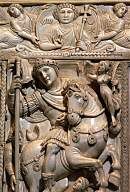
Image?
|
|
|
The Archangel Michael
Leaf of a Diptych Early 6th century Ivory London |

Image?`
|
|
|
Jacob Wrestling the Angel
from the Vienna Genesis Early 6th century AD Tempera and silver on dyed vellum Vienna |
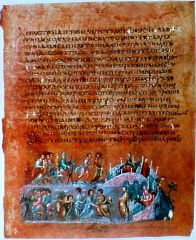
Image?
|
|
|
Christ
6th century AD Encaustic on panel Mount Sinai |

Image?
|
|
|
Virgin and Child Enthroned Between Saints and Angels
Late 6th century AD Encaustic on panel Mount Sinai |

Image?
|
|
|
The Crucifixion and Iconoclasts
from the Khludov Psalter 845 AD Tempera on vellum Moscow |
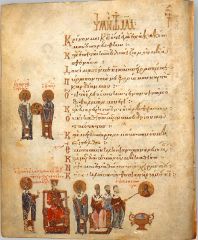
Image?
|
|
|
David Composing the Psalms
from the Paris Psalter 950 AD Tempera on vellum Paris |
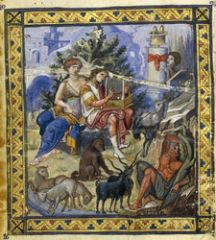
Image?
|
|
|
The Harbaville Triptych
Late 10th century AD Ivory Paris |
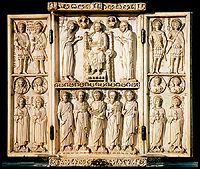
Image?
|
|
|
Christ Crowning Romanos and Eudokia
949 AD Ivory Paris |
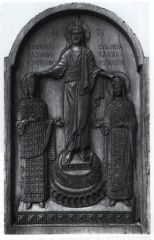
Image?
|
|
|
Dome mosaics
Church of the Dormition 11th century AD Daphni |

Image?
|
|
|
The Crucifixion
Church of the Dormition 11 century AD Mosaic Daphni |

Image?
|
|
|
Anastasis
1310 AD Fresco Istanbul |

Image?
|
|
|
Tara brooch
8th century Gilt, bronze, glass, enamel County Meath, Ireland |
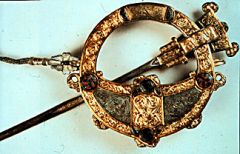
Image?
|
|
|
Golden buckle
from Sutton Hoo ship burial 7th century AD Gold London |
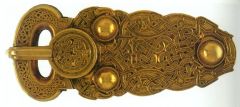
Image?
|
|
|
Hinged clasps
Sutton Hoo ship burial 7th century AD Gold, garnet, enamel London |

Image?
|
|
|
Purse cover
Sutton Hoo burial ship 7th century AD Gold, garnets, enamels London |
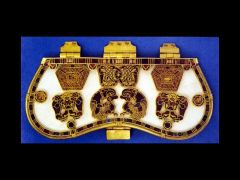
Image?
|
|
|
Animal head
from the Oseberg Ship burial 834 AD Wood Norway |
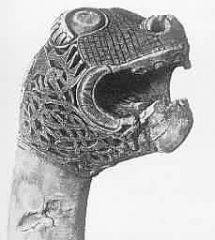
Image?
|
|
|
Symbol of St. Matthew
from Book of Durrow 680 AD Tempera on vellum Dublin |

Image?
|
|
|
Cross page
from the Lindisfarne Gospels 700 AD Tempera on vellum London |

Image?
|
|
|
St. Matthew
from the Lindisfarne Gospels 700 AD Tempera on vellum London |

Image?
|
|
|
Ezra Restoring the Bible
from the Codex Amiatinus 8th century Tempera on vellum Florence |
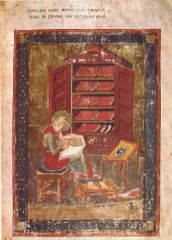
Image?
|
|
|
Chi Rho Iota page
from the Book of Kells 800 AD Ink and pigments on vellum Dublin |

Image?
|
|
|
Equestrian statue of a Carolingian ruler
9th century Bronze Paris |
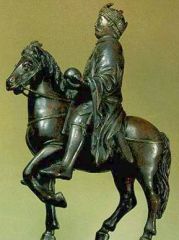
Image?
|
|
|
Psychosocial influence on stress
|
Negative stress/emotions disrupt basic biological processes, which may lead to physical disorders/disease
|
|
|
Hans Seyle
|
discovered that injection process triggered physical problems in rats regardless of placebo, called this stress
-led to study of stress physiology |
|
|
Seyle's theory
|
body's response to continued stress=
1) Alarm 2) Resistance 3) Exhaustion -combo of 3 stages=General Adaptation Syndrome (GAS) |
|
|
Alarm
|
response to immediate danger/threat
|
|
|
Resistance
|
mobilize various coping mechanisms to respond
|
|
|
Exhaustion
|
body suffers permanent damage/death (occurs if stress lasts too long)
|
|
|
Stress, the HPA Axis and the Limbic System
|
Hypothalamus=next to limbic system
-contains hippocampus -hippocampus=extremely sensitive to cortisol -when stimulated by cortisol, hippocamus mediates feedback loop between limbic system and HPA axis by turning off stress response |
|
|
Why Hippocampus' mediation of the feedback loop btw the HPA Axis and Limbic System is important
|
-overproduction of stress hormones kills off nerve cells in the hippocampus
-leads to a decrease in hippocampal functioning -can lead to dementia, susceptibility to infectious disease |
|
|
Valliant
|
studied Harvard sophomores, followed over 30 years
-found that those who developed psychological disorders/highly stressed became chronically ill or died at a higher rate -suggests that stress related causes of psychological disorders may play a role in later development of physical disorders |
|
|
Cohen et al.
|
exposed people to cold virus, found life stress directly related to who got sick
-later proved link between stress and sociability |
|
|
Depression and immune functioning
|
depression lowers immune functioning
-brings with it low self-efficacy and risky behavior -can lead to stress -stress has effect on immune system |
|
|
Autoimmune disease
|
too many helper T cells (T4 cells)
-makes immune system overreactive -begins attacking healthy cells -leaves body open to attack by antigens |
|
|
Ader and Cohen
|
rats learned through CC to supress immune system
-proved connection between nervous system and immune system -proved effect of environmental cues on the immune system |
|
|
AIDS
|
terminal illness resulting from HIV virus
-too many T4 cells-->overr. IS--> open to attack from antigens -study showed that those with AIDS who received CB stress management had less anxiety/depression, increased IS functioning |
|
|
Speigel Cancer Studies
|
86 women with terminal breast cancer
-Therapy group survived longer (3 yrs vs. 18 months) -points to psychosocial factors contributing to course/development of cancer |
|
|
Systolic blood pressure
|
pressure when the heart is pumping blood
|
|
|
Diastolic blood pressure
|
pressure between beats when the heart is at rest
|
|
|
Blood pressure measure
|
Systolic BP/Diastolic BP
|
|
|
Hypertension
|
major health concern
-can lead to stroke, heart disease, kidney disease -blood pressure goes up when blood vessels leading to major organs constrict -forces blood to central muscles, forces heart to pump harder |
|
|
Essential hypertension
|
Hypertension with no specific verifiable cause
|
|
|
2 psychological factors related to hypertension
|
hostility, impatience
-related to activation of sympathetic nervous system -causes blood vessels to constrict -highly responsive to stress |
|
|
Coronary heart disease
|
blockage of arteries supplying blood to the heart muscle (myocardium)
|
|
|
Angina pectoris
|
chest pain resulting from partial abstruction of the arteries
|
|
|
Artherosclerosis
|
occurs when fatty substance/plaque builds up inside the arteries, causing an obstruction
|
|
|
Ischemia
|
deficiency of blood to a body part resulting from constricted arteries
|
|
|
Myocardial Infarction
|
death of heart tissue when a specific artery becomes clogged with plaque
|
|
|
Western Collaborative Group Study
|
found that those with Type A beh 2X as likely to develop CHD than Type Bs
-among younger men, 6X as likely |
|
|
Framingham Heart Study
|
Type As 2X as more likely than Type Bs to develop CHD
-males more likely if of high SES, white-collar jobs -females more likely if of low SES |
|
|
Japanese men study
|
rate of Type A beh lower
-sociocultural factors important |
|
|
Anger and CHD
|
decreases pumping efficiency
-leads to CHD, CHD risk factors/signs in long run |
|
|
Anxiety/Depression and CHD
|
predictor of CHD
-may be that neurobio activation resulting from chronic negative emotions contributes to CHD |
|
|
chronic pain
|
pain that does not decrease over time, even after you have healed
-usually in muscles, tendons, joints -can be headaches/vascular pain |
|
|
factors affecting chronic pain
|
-sense of control
-efforts to cope -preexisting anxiety/negative outlook -social support |
|
|
phantom limb pain
|
thought to occur because of changes in the sensory cortex
|
|
|
neurasthenia
|
-literally, lack of nerve strength
-achy, low energy, fatigue ridden condition prevalent in 19th cent. -shares many features with Chronic Fatigue Syndrome |
|
|
Sharpe's model
|
CFS=result of high acheivement oriented stress, misinterpretation of symptoms leading to beh. avoidance, helplessness, depression, and frustration
-perpetuated by chronic inactivity -CBT but not drugs have proven effective |
|
|
Key features of major depressive episode
|
-extremely depressed mood lasting more than 2 weeks
-cognitive symptoms (worthlessness, indecisiveness) -disturbed physical functions (altered sleep, appetite, energy) -loss of interest -physical changes (somatic/vegetative symptoms) |
|
|
Key features of mania
|
-abnormally exaggerated elation, joy, euphoria
-extreme pleasure in activities -hyperactivity -little need for sleep -rapid/incoherent speech -flight of ideas -grandiose plans -irritability toward end of episode -must last at least one week |
|
|
hypomania
|
less severe manic episode that does not cause impairment in social/occupational functioning
|
|
|
unipolar mood disorder
|
experience of only depression or mania
-almost always a chronic condition |
|
|
bipolar mood disorder
|
alternating between depression and mania
|
|
|
mixed episode
|
manic symptoms mixed with depressive symptoms
-agitation, anxiety, depression, dysphoria, irritability are common |
|
|
dysthymic disorder
|
same symptoms as MDD, but milder
-persistently depressed mood that continues for at least 2 years, during which patient cannot be symptom free for more than 2 months at a time -lasts longer than MDD, most who suffer from it thought to go on to have an MDE |
|
|
double depression
|
suffer from both MDD and dsythymic disorder
-dysthymic disorder develops first, MDEs occur later in life -many with double depression never recover from dysthymia, high rates of relapse |
|
|
Mean ages of onset for MDD
|
not in treatment=25
in treatment=29 -appear to be decreasing |
|
|
Pathological grief reaction
|
-intrusive memories
-distressingly strong yearning for a loved one -avoidance of people/places that remind person of the loved one -can be predicted by past history of depressive episodes -risk goes up a year after the loss |
|
|
Bipolar I Disorder
|
MDEs alternate with full blown manic episodes
-average age of onset=18 |
|
|
Bipolar II Disorder
|
MDEs alternate with hypomania
-average age of onset=22 |
|
|
Cyclothymic Disorder
|
chronic alternation of mood elevation and depression that doesn't reach the severity of manic/MD episode
-tend to be in one mood state or the other for a period of years -strong risk of developing BPD I/II |
|
|
atypical features for depressive episodes/dsythymia
|
-consistent oversleeping/overeating
-leads to weight gain -also occurs in SAD -interest to some things -more symptoms, more severe symptoms, more suicide attempts, more comorbidity |
|
|
melancholic features of MDE/manic episode
|
severe somatic symptoms: early morning waking, weight loss, loss of libido
-excessive/inappropriate guilt -anhedonia |
|
|
psychotic features of MDE/manic episode
|
-somatic delusions (eg. believe body is rotting/deteriorating into nothingness)
-auditory hallucinations (eg. voices) |
|
|
mood incongruent hallucinations
|
associated with poor response to treatment
-greater impairment -fewer weeks with minimal symptoms |
|
|
rapid cycling (BPD I/II)
|
more than 4 episodes in one year, cycling quickly
-severe -higher probability of suicide attempts -doesn't respond well to standard treatment |
|
|
Gender and mood disorders
|
Women 2X as likely as men to have MDD/dysthymia
-BPD distributed evenly over both genders -overall, prevalence is high |
|
|
Children/Adolescents and mood disorders
|
-Deppr. disorders occur less in children than adults, but rise during adoles.
-depression more frequent than adults in adoles. -occurs more in girls, more severe -mania below age of 9 tends to be written off as hyperactivity -children, esp. boys, tend to be aggressive during depressive episodes -MDD/BPD in children predict additional disorders, substance abuse, other probs in adulthood |
|
|
Elderly and mood disorders
|
18-20% of nursing home residents may suffer deppr./MDEs
-hard to diagnose -milder symptoms more common -50% Alzheimers comorbid with depression, 33% anxiety -depression can contribute to physical disease/death |
|
|
relationship of depression/anxiety disorders
|
almost all depressed patients anxious, not all anxiety patients depressed
-many symptoms of negative affect overlap -suggests ADs and DDs on a spectrum/continuum of disorders -depression usually follows anxiety |

